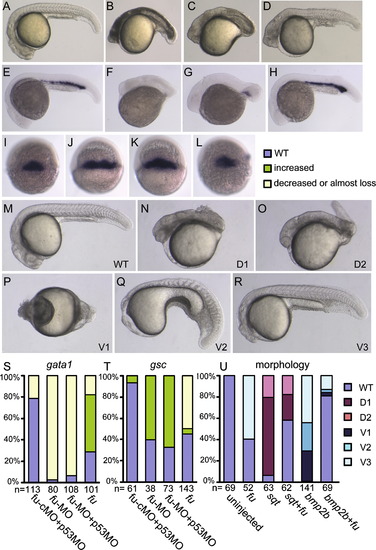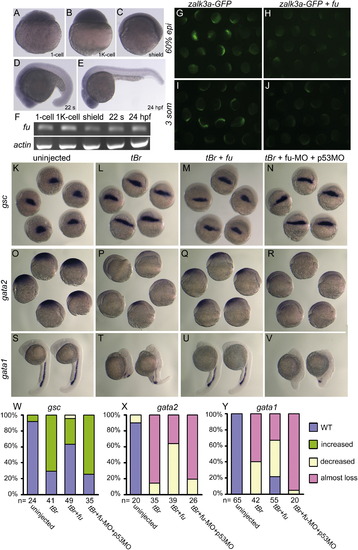- Title
-
The Fused/Smurf Complex Controls the Fate of Drosophila Germline Stem Cells by Generating a Gradient BMP Response
- Authors
- Xia, L., Jia, S., Huang, S., Wang, H., Zhu, Y., Mu, Y., Kan, L., Zheng, W., Wu, D., Li, X., Sun, Q., Meng, A., and Chen, D.
- Source
- Full text @ Cell
|
fu Participates in Dorsoventral Patterning by Regulating both Nodal and BMP Signaling Pathways in Zebrafish (A and B) Embryonic morphology at 24 hpf after downregulating or upregulating Fu activity. Embryos injected with 5 ng fu-MO exhibited more severe necrosis (B) than those injected with 5 ng fu-cMO/p53MO (A). (C) Coinjection of 5 ng p53MO with 5 ng fu-MO alleviated necrosis as observed in (B) but caused dorsalized phenotypes. (D) Overexpression of 300 pg fu mRNA led to ventralized phenotypes. (E?L) Examination of dorsoventral marker genes gata1 (24 hpf) and gsc (shield stage). Compared to control embryos injected with fu-cMO and p53MO (E and I), 5 ng fu-MO injected alone (F and J) or coinjected with 5 ng p53MO (G and K) led to both gata1 inhibition and gsc expansion. A 300 pg fu mRNA injection (H and L) led to an expansion of gata1 and a slight reduction of gsc. Statistical data are shown in (S) and (T). Embryo orientations: lateral views with head to the left for gata1; dorsal views with animal pole to the top for gsc. (M?R) Compared with the uninjected control (M), embryos injected with 0.75 pg sqt mRNA were classified into D1 and D2 groups of dorsalization (N and O). Embryos injected with 10 pg bmp2b mRNA were classified into V1?V3 groups of ventralization (P, Q, and R). (U) Statistical data for rescue experiments in which 300 pg fu mRNA was coinjected with 0.75 pg sqt or 10 pg bmp2b mRNA. Coinjection of fu mRNA rescues sqt- or bmp2b-induced dorsoventral patterning defects. See also Figure S6. |
|
Zebrafish fu Takes Part in the Degradation of BMP Receptors and the Regulation of Dorsal-Ventral Patterning, Related to Figure 7 (A?F) fu mRNA is maternally and ubiquitously distributed in the early stages of zebrafish embryos, as detected by whole-mount in situ hybridization (A?E) and RT-PCR (F) from the one-cell stage to 24 hpf. All the embryos were of the lateral views, with dorsal to the right, at the shield stage. (G?J) fu mRNA overexpression downregulates zalk3-GFP expression in vivo. (G and I) 200 pg zalk3-GFP mRNA was injected alone into one-cell stage embryos. GFP expression was observed and photographed at the 60% epiboly and 3-somite stages, respectively. (H and J) 300 pg fu mRNA was co-injected with 200 pg zalk3-GFP mRNA at the one-cell stage. Compared with injection of zalk3-GFP mRNA alone, GFP expression in the embryos co-injected with fu mRNA became obviously weaker. (K?Y) fu mRNA overexpression inhibits dorsalization caused by BMP signaling downregulation. (K?V) The genetic relationship between Fu and BMP signals in dorsal-ventral patterning. Overexpression of tBr mRNA (300 pg), which encodes a well-defined dominant negative form of the BMP type I receptor (Graff et al., 1994), caused gsc expansion in the organizer (L) and gata2 suppression in the ventral ectoderm (P) at the shield stage and gata1 suppression in the intermediate cell mass at 22 hpf (T), all of which were partially rescued by co-injection of 300 pg fu mRNA (M, Q, U). Co-injection with 5 ng fu-MO and p53MO did not show any rescue effects compared with tBr mRNA injection alone (N, R, V). (W?Y) Statistical data for (K?V) are shown. |
Reprinted from Cell, 143(6), Xia, L., Jia, S., Huang, S., Wang, H., Zhu, Y., Mu, Y., Kan, L., Zheng, W., Wu, D., Li, X., Sun, Q., Meng, A., and Chen, D., The Fused/Smurf Complex Controls the Fate of Drosophila Germline Stem Cells by Generating a Gradient BMP Response, 978-990, Copyright (2010) with permission from Elsevier. Full text @ Cell


